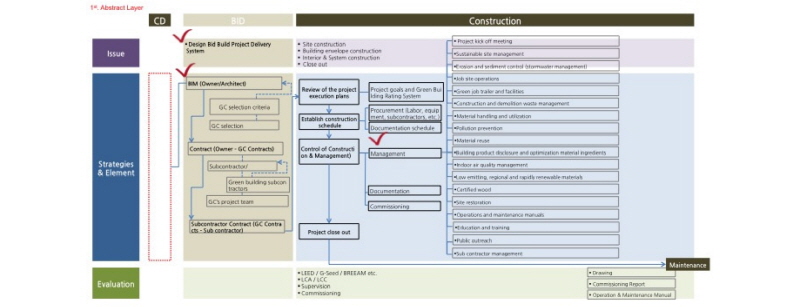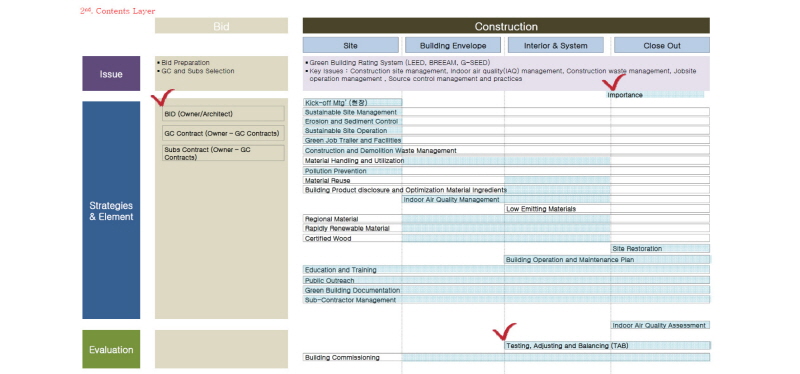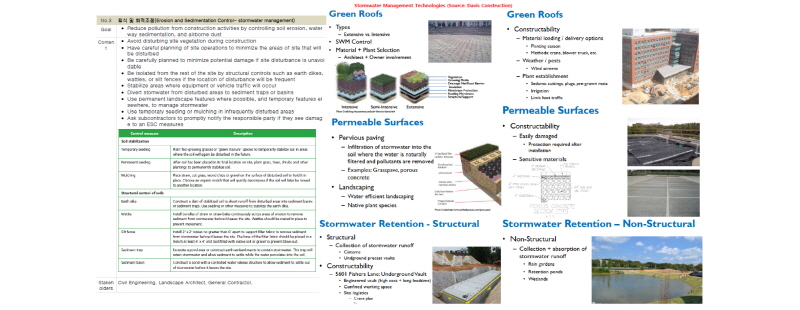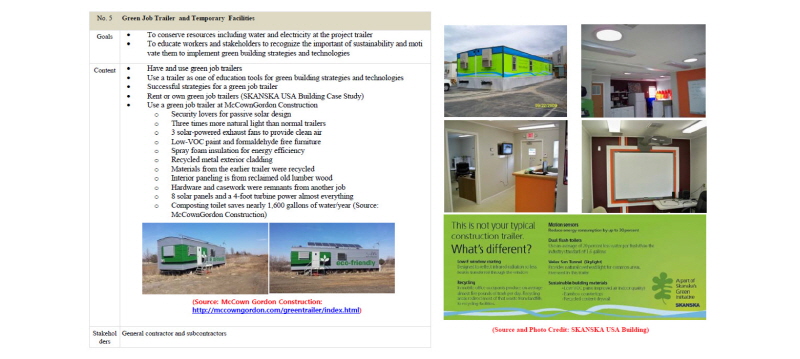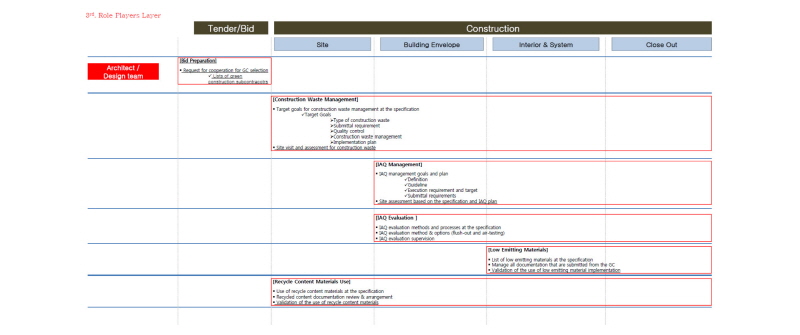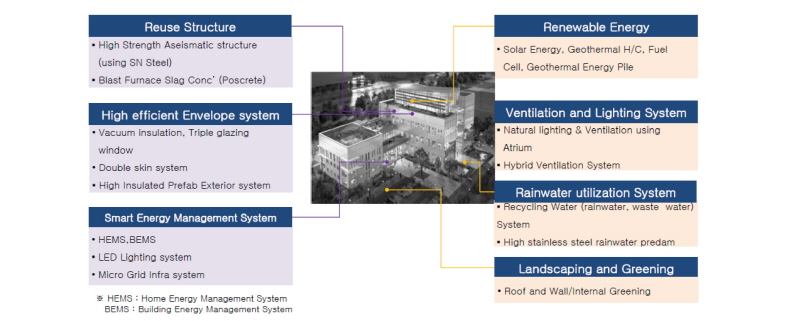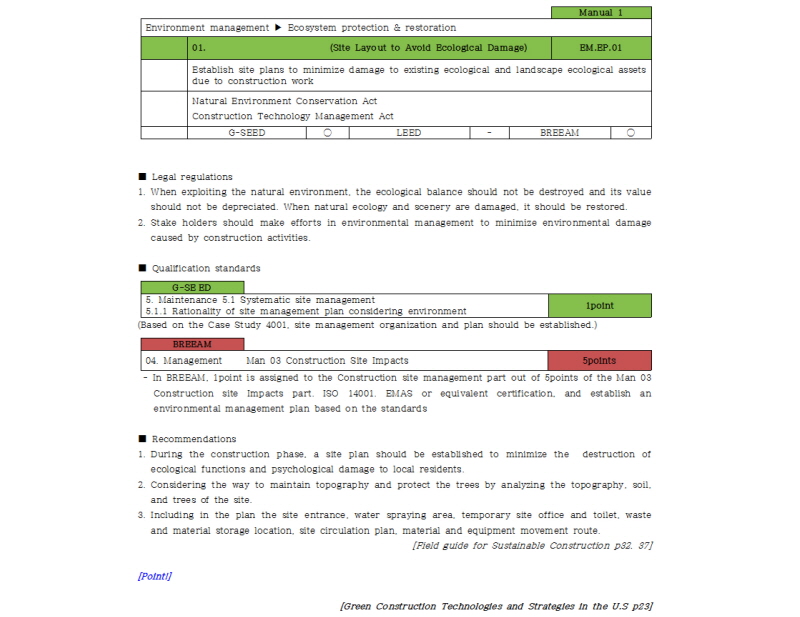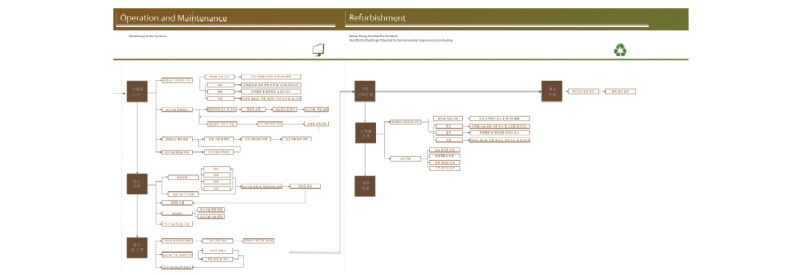Introduction
Background and Literature Review
Green Building
Green Building Process
Green Building Strategies and Technologies During the Construction Phase
Objectives and Methodology
Step 1: ICP Model Structure
Step 2: Green Construction Strategies and Technologies
Step 3: Best Practices and Practical Examples
Step 4: ICP Validation
Step 5: ICP Model and Instruction
Development of an Integrated Construction Process Model for Green Building
Discussion and Conclusions
Introduction
The sustainable movement in the construction industry has been evolving worldwide over the last two decades, seeking to mitigate the environmental problems often associated with construction activities while contributing to a higher quality of life for those living and working in the built environment. To achieve the goals of sustainability in the building sector, green design and construction principles offer a way for the construction industry to introduce numerous benefits, including better energy efficiency, improved indoor environmental quality, increased health and occupant productivity, and the minimization of resource usage, into the construction process and throughout the lifetime of the building [11,12,15,19,22].
In healthy and efficient green buildings, integrated and comprehensive processes and approaches are implemented during the planning, design, and construction phases of a building’s lifecycle to satisfy this holistic perspective [7]. Green building involves many different stakeholders, including architects, engineers, contractors, construction managers, owners, building occupants, building operators, and government agents, all of whom must fully commit to the project to ensure the success of the integrated design and construction processes that are the bedrock of green building [15,23]. One of the major success factors related to green building is the use of an integrated process that involves an intricate, multidisciplinary collaboration between a wide range of stakeholders, all of whom work closely together to generate innovative and effective green building solutions [11,24].
Process models are often used to help plan the order in which the numerous phases, steps and activities involved in every building system and project should be implemented [5,21]. In green building, the integrated design process (IDP) approach is widely used to perform complex design analyses related to energy, water, and materials, energy modeling, Life Cycle Cost (LCC) analysis, Life Cycle Assessment (LCA) analysis, and system optimization due to the increasing demand for higher levels of design integration between a building’s structural, envelope, mechanical, electrical and architectural systems [1,6,14]. In green building, the design profession, which has embraced this emerging trend, has largely dominated the discussion and the construction profession has maintained a much lower profile [19]. As a result, integrated design processes have been adopted much more widely than integrated construc-tion processes. Even though the IDP is well recognized, the industry profession is less implemented the green building practices at the construction phase. Thus, this study seeks to address this mismatch by focusing on ways to implement green building activities and processes during the construction phase of a project. The developed ICP model proposed here can help contractors and subcontractors to implement green construction activities even where they are not fully convinced of the need to do so. To successfully explore and implement green building principles on a project, it is extremely helpful to be able to follow a clear roadmap of green construction practices, in this case the new ICP model for green building. The ICP model could guide major construction stakeholders throughout the construction phase, enabling contractors, subcontractors, and design teams to successfully work together to implement green construction processes and activities. The developed ICP model describes the goals and methods involved in green construction activities, providing step-by-step procedures, major strategies and technologies, documentation requirements, and references. This paper concludes by demonstrating its use for a number of dif-ferent green construction activities to support the efforts of project teams seeking to effectively implement green construction activities and achieve the goals of sustainability in the construction industry. The ICP model can also serve as a useful education and training tool for green construction that helps construction professionals to learn about their sustainability and professional responsibilities and the resulting benefits for the construction industry as a whole. The ICP model can be efficient to construction stakeholders at the developing countries which are recognized the green construction process.
Background and Literature Review
Green Building
Construction activities have a major impact on physical development, government policies, community activities and welfare programs. However, over their entire lifecycle, construction activities are also connected with the broader problems and issues affecting the environment, including global warming, climate change, ozone deple-tion, soil erosion, desertification, deforestation, eutrophication, acidification, loss of diversity, land pollution, and consumption of valuable resources such as fossil fuels, minerals and gravels [2,8,15,20]. In an attempt to address these issues and problems, the building industry in many countries has begun to implement green building methods and technologies. Green building delivers a building that enhances the quality of life of those who live and work in it and enhance customer satisfaction by providing flexibility and ways to cater for user changes in the future, providing and supporting desirable natural and social environments, and maximizing the efficient use of resources [4,14,15]. Thus, the involvement of all the stakeholders in a building project team from the earliest stages of the design and planning process is essential to achieve the successful integration of the building into the local community, natural and economic systems [14,16]. Utilizing a collaborative team approach and an integrated de-sign and construction process are also very important to manage the incremental cost of green building implementation that is the primary barrier hindering the more widespread adoption of green building [2,3,17]. As a practice, green building integrates design and construction processes to improve sustainable site development, boost water and energy efficiency, increase the use of renewable resources, conserve materials and resources, reduce waste and toxic effluent and improve indoor environmental quality [10,15].
Green Building Process
The benefits of green building can be achieved through shifting to more integrated processes in all phases of a building’s life cycle [13]. Tasks in green building are not completed by a single action or entity but require a multidisciplinary team approach and the implementation of iterative processes during the building’s design and con-struction. Clear goals and performance targets are also essential [11,18]. The essence of green building is to adopt an integrated process that provides a more holistic approach to building planning, design, construction and ope-ration. For example, an integrated design process (IDP) intervenes in the design stage to ensure that all the issues that can be foreseen to have a significant impact on green building performance are discussed, understood and dealt with at the very beginning of the design process [13]. IDP results in an integrated systems approach that has many positive results, including achieving high levels of building performance [13,25]. IDP requires multidisciplinary collaboration among all project stakeholders and the use of energy and other simulation tools to assess potential performance; this is often achieved through a workshop or charrette with clear goals and objectives related to green building.
Green building also needs an Integrated Construction Process (ICP) if it is to fully achieve the goals of green building. ICP facilitates the construction of a building that can attain the target green building performance. Here, all stakeholders are involved in aspects such as materials selection, system performance, decreasing construction waste, improving indoor air quality, sustainable site management, and safety, among others [9,15]. It is important to appreciate that in green building, delivering the building to the owner at the conclusion of construction is just the beginning of the building’s life. Since a building consumes the majority of its energy and water during the operation phase, with significant generation of waste, it is very important that green building strategies continue to be implemented. The major green building processes during the operation phase are to optimize energy and water performance, procure green products, engage in green waste management, and maintain greenhouse functions, occupant comfort and environmental quality.
Green Building Strategies and Technologies During the Construction Phase
During the construction phase of a building’s lifecycle, careful attention must be devoted to both design strategies and construction opportunities for ensuring that a project is delivered in a sustainable fashion. To successfully implement green strategies and technologies during the construction phase, a range of green strategies and technologies can be deployed to achieve the goals of green building. Construction opportunities here include preconstruction services, minimizing site disturbance, erosion and sedimentation control, pollution prevention, sustainable site operation, construction waste management, indoor air quality management, green materials management, and commissioning, among others [9,15]. It is also important to fully document the processes implemented and the building’s performance in order to earn an internationally recognized green building certification such as Leadership in Energy and Environmental Design (LEED). Identifying green building strategies and technologies and stakeholders’ roles and responsibility at the very beginning of the construction phase is the fundamental role of ICP in green building. Since the main objective of this study is to develop an ICP model for green building, a more detailed discussion of the relevant strategies and technologies is presented below in the ICP development section.
Objectives and Methodology
The main objectives of this research were to develop an ICP model for green building that facilitates green building strategies and technologies, defines the roles and responsibilities of major stakeholders, including contractors, subcontractors, and the design team, and their relationships. In addition, the ICP model includes a detailed discussion of green construction processes that can help all stakeholders to implement green building strategies and technologies during the construction phase that support the achievement of a high performance green building. To develop the ICP model, this research selected six contractors which were listed in the 2015 top 100 green building contractors published by the Engineering News-Record. The main research method this study was to have an interview with a sustainable expert at the selected six companies. In addition, the developed ICP developed by the following five steps.
Step 1: ICP Model Structure
The first step in the development of the new ICP model was to design its structure. The resulting ICP model is composed of four layers: 1. The goals of the green construction strategies and processes, green construction strategies and technologies, the step by step procedures, and the green building requirements of green construction strategies and technologies’, 2. Testing and evaluation at the construction phase, 3. Roles and responsibilities of major stakeholders and their relationships, and 4. Best practices and practical examples of each green construction activity.
The proposed ICP model developed in this study is designed to help major stakeholders to implement green building strategies and technologies during the construction phase to achieve the goals of green building.
Step 2: Green Construction Strategies and Technologies
This study also sought to identify useful green construction strategies and technologies, including their goals in construction. This step is very important as it describes the goals of each of the green construction strategies and technologies that can be implemented at the construction phase and demonstrates how each stakeholder needs to perform their daily practices, highlighting the need to collaboration closely with other stakeholders in order to eventually achieve the goals of green building. Finally, this stage identifies a detailed analysis method and the resources needed. This study collected green construction strategies and technologies through interviewing with the sustainable vice president and director at six different major contractors in the United States.
Step 3: Best Practices and Practical Examples
In order to successfully implement green construction strategies and technologies, a clear explanation of best practices and practical examples of their application are very important since they can provide invaluable information regarding appropriate means and methods, procedures, and applicable tools. These involve approaches that can be implemented to manage people, equipment, information, and other resources to achieve the goals of a specific project related to schedule, budget, quality, and sustainability, including green procurement, logistics and transportation, job site operations, education and training, management plans, the impact on the surrounding neighborhood and public outreach. The best practices and the practical examples provided serve as useful education tools and guidelines for green building during the construction phase. The best practices and practical examples are collected from six US large contractors even though three of them are based on the UK, Sweden, and Australia.
Step 4: ICP Validation
The validation of the proposed ICP model was also important in order to disseminate this ICP model to construction companies and real world projects. Once the project team had developed the new ICP model, the next step was to conduct a comprehensive validation process through a group review performed by experts from a con-struction company, a professor, an architect and a researcher. This validation process fine-tuned the ICP model to ensure that it is a realistic approach that can usefully be applied to actual construction processes on construction sites.
Step 5: ICP Model and Instruction
The ICP model developed for this study consists of four main layers that demonstrate green construction processes, outline their purpose and step-by-step procedures, specify the requirements to achieve their purposes and the roles and responsibilities of the main stakeholders, and provide examples of best practices. The new model can also be used in project to educate stakeholders regarding the benefits to be gained through achieving the goals of green building during the construction phase. The ICP model incorporates green construction guidelines that can provide a supplementary explanation of green construction implementation during the construction phase. Thus, the proposed ICP model can be used alongside a green construction site management plan to monitor and control green building processes during the construction phase. The newly developed ICP model can change the paradigm of construction processes by considering potential green building processes at the construction phase, especially as it incorporates the “Green Construction Site Management Manual” developed by the research team.
Development of an Integrated Construction Process Model for Green Building
The process of developing a new ICP model for green building started by examining the green building strategies and technologies that can potentially be deployed during the construction phase of project development. A four-layer model (ICP Model) was constructed that facilitates the processes for green construction activities based on the Design Bid Build (DBB) project delivery system. Although this suffers from a number of limitations related to the contractor’s involvement at the design phase, its widespread use as the predominant project delivery system in South Korea was considered to outweigh these disadvantages. To address these limitations, additional elements were incorporated into the new ICP model to highlight the areas where contractors could make a substantial contribution during the design phase by providing a preconstruction service to help achieve the goals of green building. The proposed ICP model provides a comprehensive list of green construction activities, the goals and procedures for each, the roles and responsibilities of major stakeholders, rating system requirements (submittals), the necessary forms and management strategies, and best practices and practical examples of green construction activities.
The new ICP consists of four layers: the initial ‘Abstract Layer’, which is shown in Figure 1, the second ‘Content Layer’, the third ‘Stakeholder Roles Layer’, and the final ‘Practical Examples Layer’. The model starts with the BID stage of the project, examining how best to select a general contractor and subcontractors capable of successfully completing the project. At the BID state, the most important consideration is to select a general contractor based on value based selection criteria such as their project and green building experience, team organization, team members, and so on. The first layer of ‘Abstract Layer’ demonstrate the structure of the ICP model and also iden-tified the list of green construction technologies and strategies from ‘project kick-off meeting’ to ‘subcontractor management’.
The second layer of the ICP model divides the construction phase into four areas: ‘Site Construction’, ‘Building Envelope Construction’, ‘Interior & System Construction’ and ‘Close Out’. After reviewing the project goals and execution plans, including drawing sets and specifications, along with any requirements for green building rating certification, a schedule is established for procurement, labor, and materials that require special or additional ‘lead time’ needed by the green activities. The main section of this layer of the new ICP model then focuses on how to manage the green building activities, including strategies and technologies, during the construction phase, as shown in Figure 2. The documentation required for green building rating must be prepared and a comprehensive building commissioning process carried out in order to successfully achieve green building certification and ensure that the building operates as the owner and designer intended and that the building operators know how to operate and maintain its systems and equipment. This study demonstrated18 green building activities that could potentially be completed during the construction phase to achieve the goals of green building and are therefore included in the new ICP model, including items such as ‘project kick-off meeting’, ‘sustainable site management’, and so on (Figure 1). Areas related to evaluation assessments tools and potential rating systems such as LEED and G-SEED are also included here.
The second layer of the ICP model (Figure 2), the ‘Content Layer’, provides a detailed breakdown of the content of each of the green construction activities selected, including their goals and requirements, the step-by-step procedures involved, an explanation of the measurement and assessment methods to be implemented, illustrations of the relevant green construction practices, the type of green rating system documentation required and a list of useful references. The second layer starts by considering ‘preconstruction services by a general contractor’ in rela-tion to green building. In general, a construction company will help the project team to obtain complete, cons-tructible and value engineered construction documents, mainly in the form of drawings and detailed specifications, by providing preconstruction services in the initial development and design stages. The primary tasks performed during the preconstruction phase by a general contractor relating to green building are therefore ‘team approach’, ‘consideration, analysis, and implementation of green building alternatives’, ‘life cycle cost analysis along with initial cost premium’, ‘value engineering’, ‘commissioning planning and analysis’, ‘constructability review’, ‘site logistics’, and ‘green building charrette’. These green tasks add value to the project by contributing to the achie-vement of the project goals related to sustainability, with the general contractor serving as a major stakeholder in terms of these green construction activities.
The example of the type of issues typically considered within the ‘Second Layer: Content’ concerns ‘Erosion and sedimentation control–stormwater management’ (Figure 3). The purpose of this green building activity is to reduce erosion and sedimentation by controlling soil erosion, waterway sedimentation, and airborne dust. This pro-cess begins by creating and implementing an Erosion and Sedimentation Control (ESC) plan for all the construction activities to be performed during the project. The ESC plan also covers all the minimum requirements for dealing with erosion and sedimentation specified by the relevant building codes and government regulations. The proposed ICP model also provides a number of methods and strategies for controlling erosion and sedimentation, including soil stabilization methods and structural control methods such as earth dikes, wattle, silt fences, sediment traps, and sediment basins.
The other example of a green construction activity in the ‘Content Layer’ is ‘Green job trailer and facilities’ (Figure 4). The purpose of a green job trailer is to reduce energy and water consumption in the temporary facilities provided for workers at the construction site and help educate them about green building strategies and technologies using the daily operating facilities at the project site. The ICP includes examples of the green job site trailers used by two U.S. construction companies, Skanska USA and McCown Gordon Construction, for their green building projects. These green job site trailers demonstrate basic green building strategies and technologies, including the use of daylighting, recycling, solar PV, low VOC paint, insulation, water saving fixtures, and motion sensors, among others. They also serve as education resources and teaching tools for construction workers and the project stake-holders, encouraging them to engage fully in the effort to achieve the goals of sustainability for their construction project. Using a green jobsite trailer makes it easy to explain green design building strategies and technologies with real examples, thus enhancing the efficiency and effectiveness of education and training.
The third layer of the new ICP model, ‘Stakeholder Roles’, focuses on the roles and responsibilities of the main stakeholders, including the design team (architects and engineers), the general contractor, and the suppliers. This layer is divided into four stages: ‘Site’, ‘Building Envelope’, ‘Interior’, and ‘Close-Out’ for the construction phase. The main roles and responsibilities of the design team are to define the intent of each of the green construction activities, ‘the requirements to achieve the green construction activities’, ‘the documentation needs’, and ‘the managing and checking requirements for a contractor’ (Figure 5). The general contractor works closely with the design team, specifying the activities and requirements involved in implementing the green construction activities listed in the first layer and providing detailed submittal requirements. The subcontractors’ duties and respon-si-bilities related to the green construction activities are considered here. For example, subcontractors must be aware of the need to immediately notify the general contractor if any erosion and sedimentation issues arise at the job site. In addition, all subcontractors must comply with the project’s erosion and sedimentation control and imple-men-tation plan that can help all stakeholders to implement green building strategies and technologies at the construction phase.
The fourth layer of the ICP model, ‘Practical Examples’, demonstrates efficient ways to complete green con-struction activities during the construction project and provides sample templates of the documentation required by the major green building certification systems, including LEED and G-SEED. In addition, this study also demon-strated all green building design, construction and operation processes based on ‘POSCO Green Building, the actual test-bed project this study (Figure 6).This layer helps major stakeholders at the construction phase by pro-vi-ding a set of benchmarks for green construction activities that can be applied to multiple project teams. One example of the items included in the fourth layer is related to ‘building commissioning’. Here, the suggested best practices include ‘a request for commissioning proposal’, ‘a sample of commissioning specifications’, ‘the com-missioning plan’, ‘the field schedule for commissioning’, ‘CX deficiencies Log’, ‘a field report’, ‘service scope and schedule of value for commissioning services’, ‘the O&M manual’, and ‘the final commissioning report’. The study team selected the best practices based on input from a panel of experts that consisted of a university architect and the chair (an architect) and vice chair (a project manager) of a USGBC regional chapter.
The developed ICP model also incorporates a ‘Green Construction Site Management Manual’ developed by the research team that lists green construction activities and describes the goals of each, any relevant laws and statutory requirements, the related green building rating system requirements for certification, the step-by-step procedures involved in implementing the activity, and a detailed explanation of the rationale behind it. In addition, the green construction site management manual also provides the minimum requirement related to environmental protection and green building acted by central and local governments in South Korea. An example of each green construction activity is also provided, along with recommendations for appropriate strategies for green building, a list of useful references and a sample check list. The green construction site manual also provides the standard requirements for achieving three green building rating systems including LEED, BREEAM, and G-SEED.
Used in conjunction with this green construction site management manual, the new ICP model presented here facilitates the efforts of all the major stakeholders involved in a project during the construction phase to implement green construction strategies and technologies effectively and efficiently, not least by providing clear descriptions of the roles and responsibilities of all the major stakeholders, including the contractor, the subcontractors and the design team, as well as the relationships between them. The ICP model and green construction site management manual can not only guide a field project team seeking to implement green building strategies and technologies during the construction phase but will also serve as a useful education and training tool for project managers, superintendents, and other stakeholders. Finally, the ICP model for green building can be applied alongside the IDP and IOP models previously developed by the same research group to fully cover the whole life cycle of a building (Figures 8 and 9) The IDP and ICP also have four layers to demonstrate green design and operation processes to major construction stakeholders. The resulting green building framework will help all construction stakeholders to implement green building activities and strategies that achieve the goals of sustainability in the built environment.
Discussion and Conclusions
A green building approach is vital if we are to achieve the short- and long-term goals of sustainability, including conserving energy, water, and materials savings and improving indoor air quality, in the built environment. To successfully implement green building methods, all stakeholders including architects, engineers, and contractors would benefit from a comprehensive framework or model that incorporates green building strategies and techno-lo-gies in every phase of a building’s life cycle. As part of the effort to construct such a framework, this research developed the ICP model to guide major stakeholders during the construction phase and help them to successfully implement green building strategies and technologies. The ICP model developed in this study began by incor-po-rating as many as possible green construction activities along with a list of evaluation and assessment methods, inclu-ding Life Cycle Assessment (LCC) and Life Cycle Cost Analysis (LCCA). The resulting ICP model allows all the project stakeholders to identify and implement the best practices for these green construction activities and fulfill the roles and responsibilities expected of all stakeholders, which are both major success factors for green building. In addition, contractors’ and subcontractors’ field workers and managers who lack extensive experience in green building can consult the model to fully understand what is expected of them regarding green construction activities and use it to guide their step by step processes at the construction site. It will help contractors to identify key deci-sion points and highlight the information they need to consider in making these key decisions related to green building. The new ICP model will also help project teams to successfully manage the cost, quality, and time needed for the project aspects related to green building and thus minimize the project duration, lower construction costs and improve the quality of the resulting product.
The ICP model supports stakeholders’ efforts to produce adequate construction documentation, an area that is often a problem for both contractors and subcontractors. The comprehensive documentation process for integrated construction included in the ICP model minimizes the need for additional documentation specifically related to green building, greatly facilitating the certification process for green building in the construction industry. The ICP model thus facilitates the process, documentation, and implementation requirements for the various green building rating systems by providing a clear demonstration of the green construction activities implemented, along with the green building rating system’s requirements.
The use of an ICP model such as the one proposed here facilitates the early generation of requirements, thus enhan-cing the effectiveness and efficiency of the green construction process. The ICP model for green building developed in this study also provides a useful teaching tool for educating project managers, superintendents, foremen, sub-con-tractors, and others involved in a construction project regarding both the theoretical and practical aspects of green building technologies and methods. The ICP model not only presents the objectives of each of the green construc-tion activities described, but also includes the step-by-step procedures needed to achieve individual green construc-tion activities, along with the relevant documentation and measurement tools and examples of best practice. The proposed ICP model is thus confidently expected to enhance stakeholders’ competencies related to green building at the construction phase.
This ICP model for green building can be used alongside the IDP and IOP models previously developed by the same research group and with other green building tools to promote green building in both new construction and existing construction projects to achieve the goals of sustainability in the built environment throughout the entire building lifecycle. These models can not only minimize the environmental problems and issues that are all too often associated with construction activities in the built environment but also enhance the social and economic benefits gained as a result of green building implementation. The development of ICP can help construction stakeholders in the developing countries who want to implement green building practices at the construction phase. In addition, this ICP model can be one of good teaching and education tools for green building strategies and technologies for construction managers and construction students.



